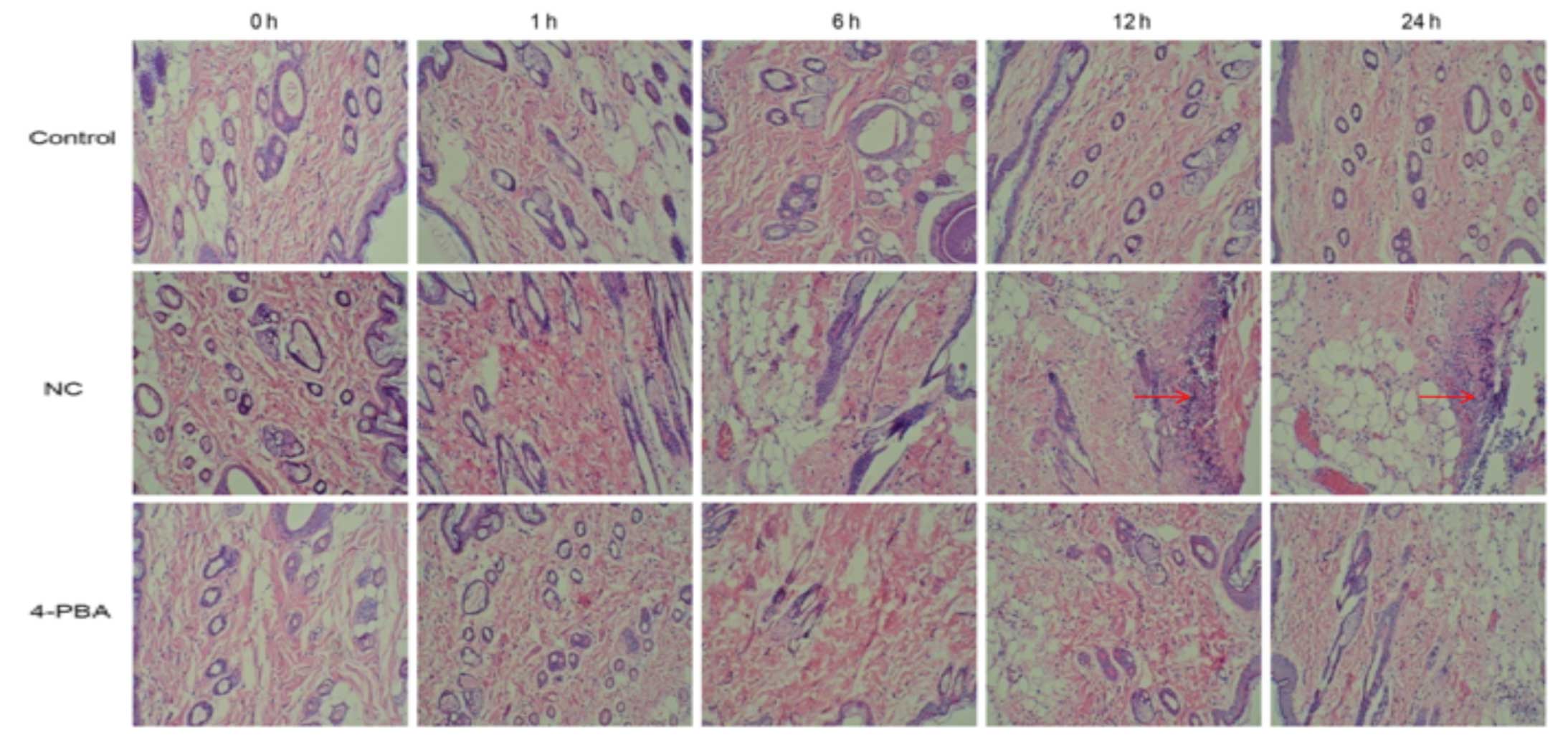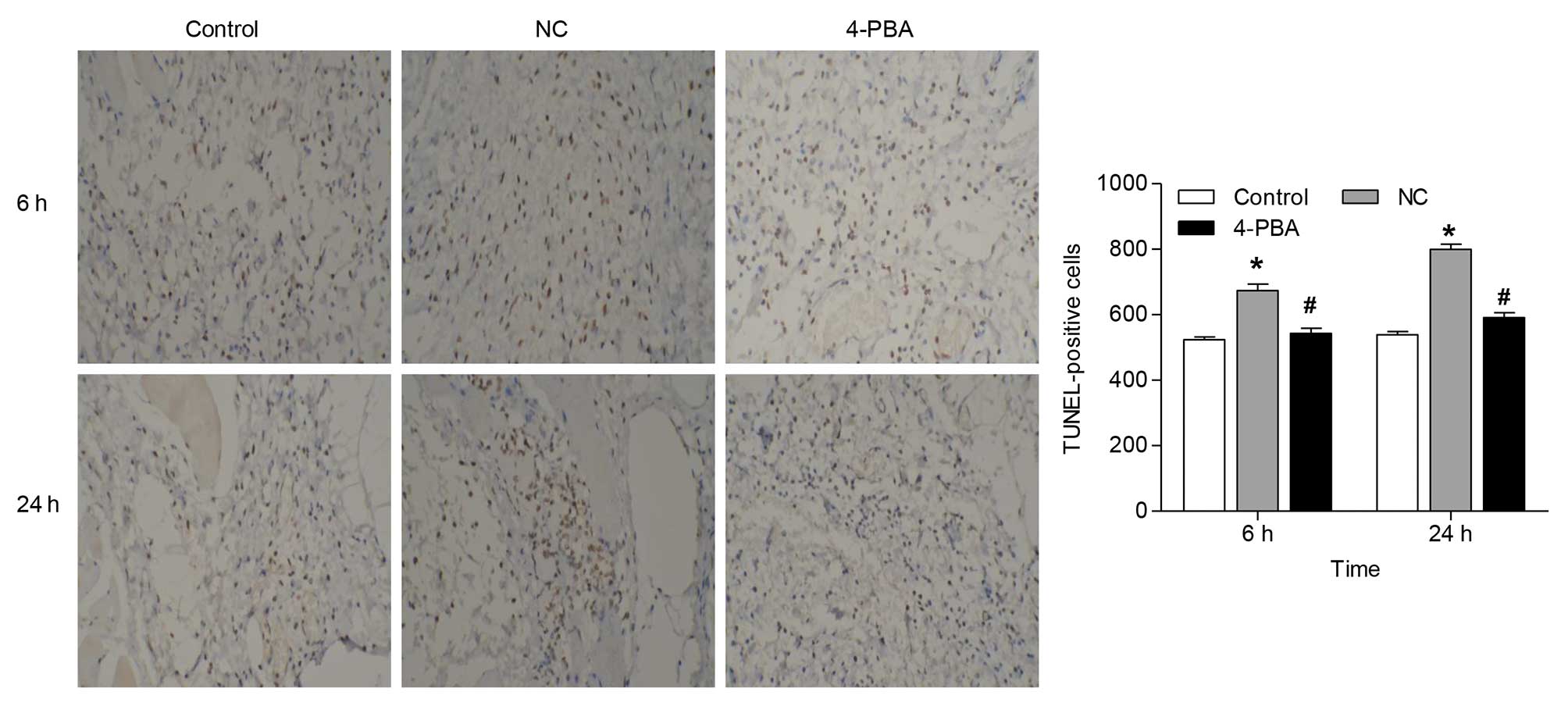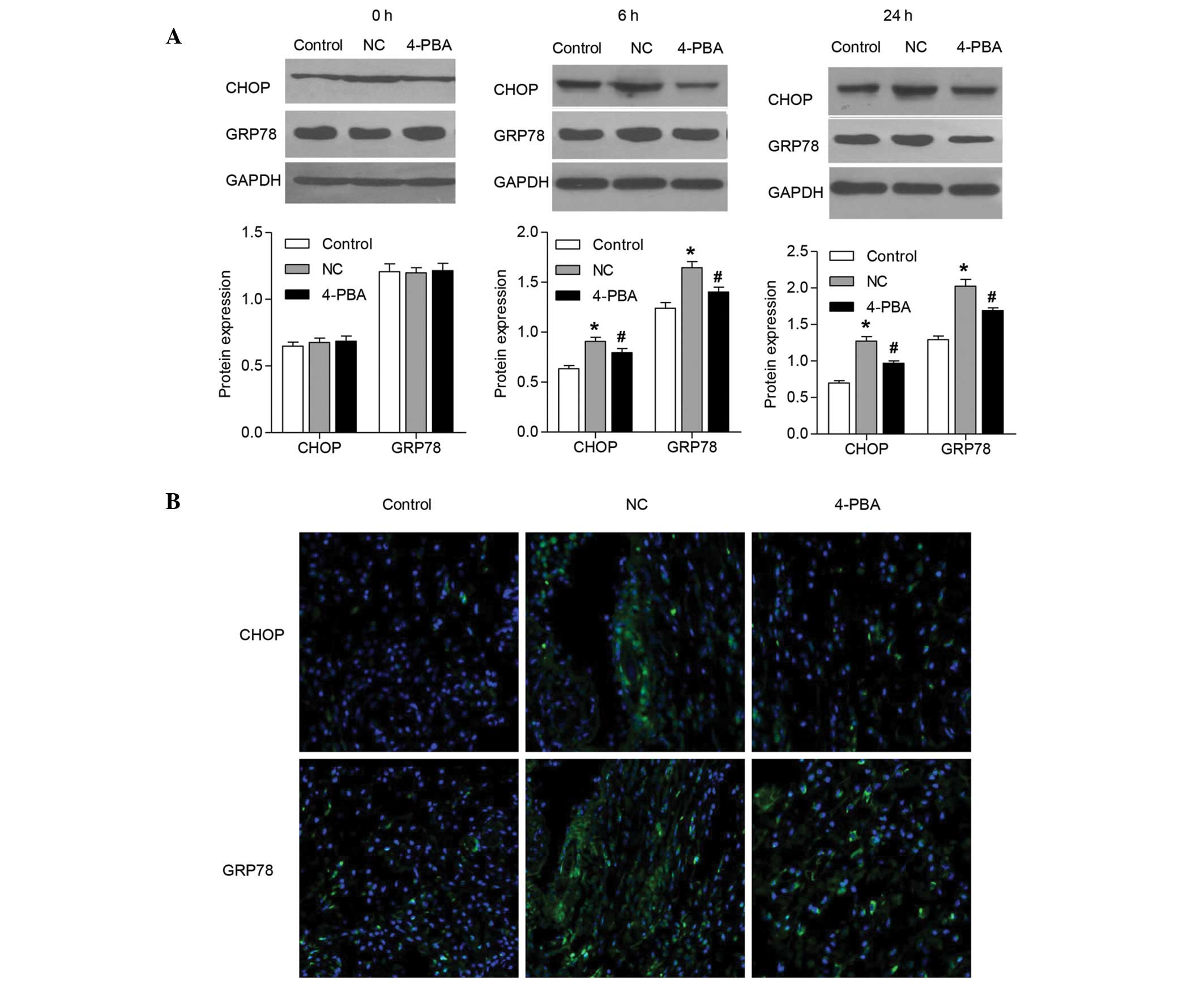|
1
|
Yao ST: Vascular implantation into skin
flap: Experimental study and clinical application: A Preliminary
report. Plast Reconstr Surg. 68:404–409. 1981. View Article : Google Scholar : PubMed/NCBI
|
|
2
|
Manson PN, Anthenelli RM, Im MJ, Bulkley
GB and Hoopes JE: The role of oxygen-free radicals in ischemic
tissue injury in island skin flaps. Ann Surg. 198:87–90. 1983.
View Article : Google Scholar : PubMed/NCBI
|
|
3
|
Ron D and Walter P: Signal integration in
the endoplasmic reticulum unfolded protein response. Nat Rev Mol
Cell Biol. 8:519–529. 2007. View
Article : Google Scholar : PubMed/NCBI
|
|
4
|
Hosoi T and Ozawa K: Endoplasmic reticulum
stress in disease: Mechanisms and therapeutic opportunities. Clin
Sci (Lond). 118:19–29. 2009. View Article : Google Scholar
|
|
5
|
Hotamisligil GS: Endoplasmic reticulum
stress and the inflammatory basis of metabolic disease. Cell.
140:900–917. 2010. View Article : Google Scholar : PubMed/NCBI
|
|
6
|
Zhang K and Kaufman RJ: From
endoplasmic-reticulum stress to the inflammatory response. Nature.
454:455–462. 2008. View Article : Google Scholar : PubMed/NCBI
|
|
7
|
Anelli T and Sitia R: Protein quality
control in the early secretory pathway. EMBO J. 27:315–327. 2008.
View Article : Google Scholar : PubMed/NCBI
|
|
8
|
Kim I, Shu CW, Xu W, Shiau CW, Grant D,
Vasile S, Cosford ND and Reed JC: Chemical biology investigation of
cell death pathways activated by endoplasmic reticulum stress
reveals cytoprotective modulators of ASK1. J Biol Chem.
284:1593–1603. 2009. View Article : Google Scholar :
|
|
9
|
Endo M, Mori M, Akira S and Gotoh T: C/EBP
homologous protein (CHOP) is crucial for the induction of
caspase-11 and the pathogenesis of lipopolysaccharide-induced
inflammation. J Immunol. 176:6245–6253. 2006. View Article : Google Scholar : PubMed/NCBI
|
|
10
|
Li J, Wang JJ, Yu Q, Wang M and Zhang SX:
Endoplasmic reticulum stress is implicated in retinal inflammation
and diabetic retinopathy. FEBS Lett. 583:1521–1527. 2009.
View Article : Google Scholar : PubMed/NCBI
|
|
11
|
Leem J and Koh EH: Interaction between
mitochondria and the endoplasmic reticulum: Implications for the
pathogenesis of type 2 diabetes mellitus. Exp Diabetes Res.
2012:2429842012. View Article : Google Scholar
|
|
12
|
Kang HL, Benzer S and Min KT: Life
extension in Drosophila by feeding a drug. Proc Natl Acad Sci USA.
99:838–843. 2002. View Article : Google Scholar : PubMed/NCBI
|
|
13
|
Andreassi C, Angelozzi C, Tiziano FD,
Vitali T, De Vincenzi E, Boninsegna A, Villanova M, Bertini E, Pini
A, Neri G and Brahe C: Phenylbutyrate increases SMN expression in
vitro: Relevance for treatment of spinal muscular atrophy. Eur J
Hum Genet. 12:59–65. 2004. View Article : Google Scholar
|
|
14
|
Dasgupta S, Zhou Y, Jana M, Banik NL and
Pahan K: Sodium phenylacetate inhibits adoptive transfer of
experimental allergic encephalomyelitis in SJL/J mice at multiple
steps. J Immunol. 170:3874–3882. 2003. View Article : Google Scholar : PubMed/NCBI
|
|
15
|
Burrows JA, Willis LK and Perlmutter DH:
Chemical chaperones mediate increased secretion of mutant
alpha1-antitrypsin (alpha1-AT) Z: A potential pharmacological
strategy for prevention of liver injury and emphysema in alpha 1-AT
deficiency. Proc Natl Acad Sci USA. 97:1796–1801. 2000. View Article : Google Scholar
|
|
16
|
Rubenstein RC and Zeitlin PL: Sodium
4-phenylbutyrate down-regulates Hsc70: Implications for
intracellular trafficking of DeltaF508-CFTR. Am J Physiol Cell
Physiol. 278:C259–C267. 2000.PubMed/NCBI
|
|
17
|
Perlmutter DH: Chemical chaperones: A
pharmacological strategy for disorders of protein folding and
trafficking. Pediatr Res. 52:832–836. 2002. View Article : Google Scholar : PubMed/NCBI
|
|
18
|
Yam GH, Gaplovska-Kysela K, Zuber C and
Roth J: Sodium 4-phenylbutyrate acts as a chemical chaperone on
misfolded myocilin to rescue cells from endoplasmic reticulum
stress and apoptosis. Invest Ophthalmol Vis Sci. 48:1683–1690.
2007. View Article : Google Scholar : PubMed/NCBI
|
|
19
|
Shimamatsu K and Wanless IR: Role of
ischemia in causing apoptosis, atrophy, and nodular hyperplasia in
human liver. Hepatology. 26:343–350. 1997. View Article : Google Scholar : PubMed/NCBI
|
|
20
|
Kabeer FA, Sreedevi GB, Nair MS,
Rajalekshmi DS, Gopalakrishnan LP, Kunjuraman S and Prathapan R:
Antineoplastic effects of deoxyelephantopin, a sesquiterpene
lactone from Elephantopus scaber, on lung adenocarcinoma (A549)
cells. J Integr Med. 11:269–277. 2013. View Article : Google Scholar : PubMed/NCBI
|
|
21
|
Payton JE, Grieselhuber NR, Chang LW,
Murakami M, Geiss GK, Link DC, Nagarajan R, Watson MA and Ley TJ:
High throughput digital quantification of mRNA abundance in primary
human acute myeloid leukemia samples. J Clin Invest. 119:1714–1726.
2009. View
Article : Google Scholar : PubMed/NCBI
|
|
22
|
Hosoi T, Okuma Y and Nomura Y: Expression
of leptin receptors and induction of IL-1beta transcript in glial
cells. Biochem Biophys Res Commun. 273:312–315. 2000. View Article : Google Scholar : PubMed/NCBI
|
|
23
|
Kerrigan CL and Stotland MA: Ischemia
reperfusion injury: A review. Microsurgery. 14:165–175. 1993.
View Article : Google Scholar : PubMed/NCBI
|
|
24
|
Hatoko M, Tanaka A, Kuwahara M, Yurugi S,
Iioka H and Niitsuma K: Difference of molecular response to
ischemia-reperfusion of rat skeletal muscle as a function of
ischemic time: Study of the expression of p53, p21(WAF-1), Bax
protein, and apoptosis. Ann Plast Surg. 48:68–74. 2002. View Article : Google Scholar : PubMed/NCBI
|
|
25
|
Kuo YR, Jeng SF, Wang FS, Huang HC, Wei FC
and Yang KD: Platelet glycoprotein IIb/IIIa receptor antagonist
(abciximab) inhibited platelet activation and promoted skin flap
survival after ischemia/reperfusion injury. J Surg Res. 107:50–55.
2002. View Article : Google Scholar : PubMed/NCBI
|
|
26
|
Siemionow M and Arslan E:
Ischemia/reperfusion injury: A review in relation to free tissue
transfers. Microsurgery. 24:468–475. 2004. View Article : Google Scholar : PubMed/NCBI
|
|
27
|
Qi X, Hosoi T, Okuma Y, Kaneko M and
Nomura Y: Sodium 4-phenylbutyrate protects against cerebral
ischemic injury. Mol Pharmacol. 66:899–908. 2004. View Article : Google Scholar : PubMed/NCBI
|
|
28
|
Mizukami T, Orihashi K, Herlambang B,
Takahashi S, Hamaishi M, Okada K and Sueda T: Sodium
4-phenylbutyrate protects against spinal cord ischemia by
inhibition of endoplasmic reticulum stress. J Vasc Surg.
52:1580–1586. 2010. View Article : Google Scholar : PubMed/NCBI
|
|
29
|
Ono Y, Shimazawa M, Ishisaka M, Oyagi A,
Tsuruma K and Hara H: Imipramine protects mouse hippocampus against
tunicamycin-induced cell death. Eur J Pharmacol. 696:83–88. 2012.
View Article : Google Scholar : PubMed/NCBI
|
|
30
|
Nakayama Y, Endo M, Tsukano H, Mori M,
Oike Y and Gotoh T: Molecular mechanisms of the LPS-induced
non-apoptotic ER stress-CHOP pathway. J Biochem. 147:471–483. 2010.
View Article : Google Scholar
|
|
31
|
Vilatoba M, Eckstein C, Bilbao G, Smyth
CA, Jenkins S, Thompson JA, Eckhoff DE and Contreras JL: Sodium
4-phen-ylbutyrate protects against liver ischemia reperfusion
injury by inhibition of endoplasmic reticulum-stress mediated
apoptosis. Surgery. 138:342–351. 2005. View Article : Google Scholar : PubMed/NCBI
|
|
32
|
Kim HJ, Jeong JS, Kim SR, Park SY, Chae HJ
and Lee YC: Inhibition of endoplasmic reticulum stress alleviates
lipopolysaccharide-induced lung inflammation through modulation of
NF-κB/HIF-1α signaling pathway. Sci Rep. 3:11422013. View Article : Google Scholar
|
|
33
|
Wang XB, Huang XM, Ochs T, Li XY, Jin HF,
Tang CS and Du JB: Effect of sulfur dioxide preconditioning on rat
myocardial ischemia/reperfusion injury by inducing endoplasmic
reticulum stress. Basic Res Cardiol. 106:865–878. 2011. View Article : Google Scholar : PubMed/NCBI
|
|
34
|
Peralta C and Brenner C: Endoplasmic
reticulum stress inhibition enhances liver tolerance to
ischemia/reperfusion. Curr Med Chem. 18:2016–2024. 2011. View Article : Google Scholar : PubMed/NCBI
|













